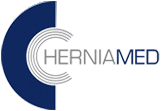2.5 Gastrointestinal passage examination
This entails X-ray examination of the upper digestive tract (oesophagus, stomach and small intestine) with use of a contrast medium that helps to identify any disease-induced changes in this area. For example, any intestinal loops displaced into a hernial sac can be easily shown. Gastrointestinal passage examination is thus used primarily for diaphragmatic hernias (hiatal hernia) and internal hernias.
After the patient has swallowed the contrast medium, X-ray images are continuously taken to check the integrity (regular structure) of the surfaces of the mucous membranes. The physician can view the images on a monitor while they are being taken. The patient also ingests a gas-forming granulate or powder so that the organs of the gastrointestinal tract become filled with gas, giving rise to expansion of wall structures and making it easier to detect any irregularities. X-ray images of different body positions are taken until all important images needed for a diagnosis are available.
The contrast medium can give rise to short-term diarrhoea and flatulence. One major disadvantage of gastrointestinal passage examination is the relatively high radiation dose, which is why this technique is only used if no other alternative is available. To assure good examination results, it is important that the patient be fasting. That means that on the day before the examination until the end of examination he/she must not take any nutrition, and must also avoid coffee, milk, cigarettes. On the day prior to the examination, the patient should avoid any flatulence-inducing foods (pulses, etc.). In a discussion with the doctor, the patient should also arrange to take any medication only later on the day of the examination.
